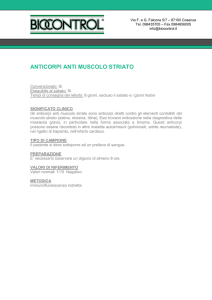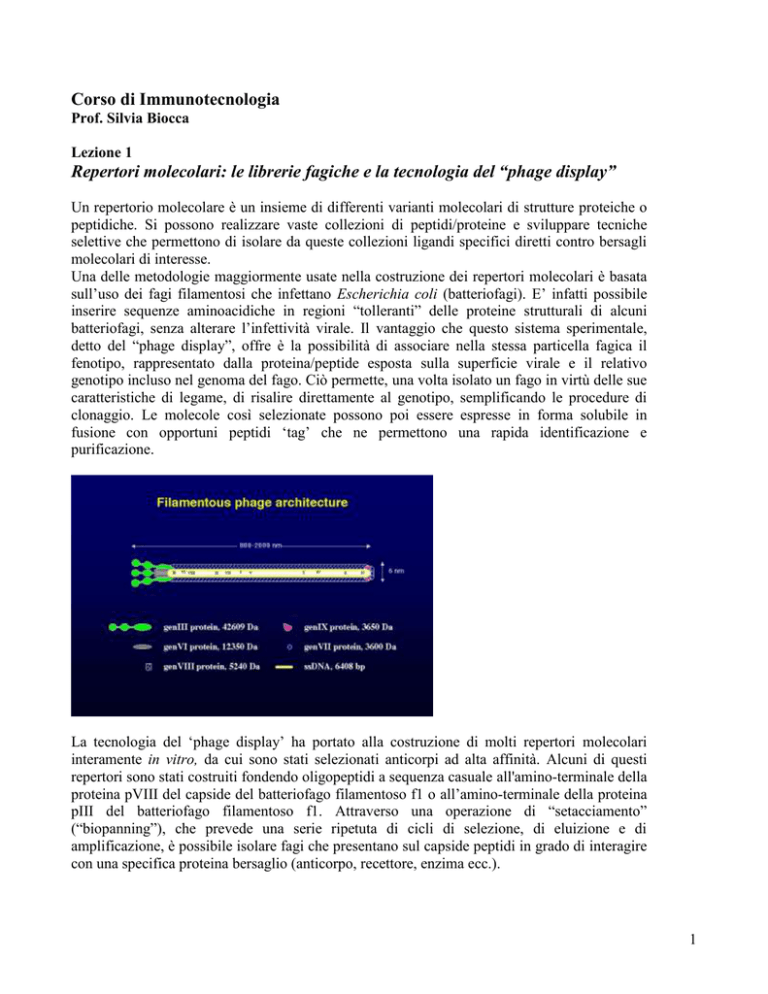
Corso di Immunotecnologia
Prof. Silvia Biocca
Lezione 1
Repertori molecolari: le librerie fagiche e la tecnologia del “phage display”
Un repertorio molecolare è un insieme di differenti varianti molecolari di strutture proteiche o
peptidiche. Si possono realizzare vaste collezioni di peptidi/proteine e sviluppare tecniche
selettive che permettono di isolare da queste collezioni ligandi specifici diretti contro bersagli
molecolari di interesse.
Una delle metodologie maggiormente usate nella costruzione dei repertori molecolari è basata
sull’uso dei fagi filamentosi che infettano Escherichia coli (batteriofagi). E’ infatti possibile
inserire sequenze aminoacidiche in regioni “tolleranti” delle proteine strutturali di alcuni
batteriofagi, senza alterare l’infettività virale. Il vantaggio che questo sistema sperimentale,
detto del “phage display”, offre è la possibilità di associare nella stessa particella fagica il
fenotipo, rappresentato dalla proteina/peptide esposta sulla superficie virale e il relativo
genotipo incluso nel genoma del fago. Ciò permette, una volta isolato un fago in virtù delle sue
caratteristiche di legame, di risalire direttamente al genotipo, semplificando le procedure di
clonaggio. Le molecole così selezionate possono poi essere espresse in forma solubile in
fusione con opportuni peptidi ‘tag’ che ne permettono una rapida identificazione e
purificazione.
La tecnologia del ‘phage display’ ha portato alla costruzione di molti repertori molecolari
interamente in vitro, da cui sono stati selezionati anticorpi ad alta affinità. Alcuni di questi
repertori sono stati costruiti fondendo oligopeptidi a sequenza casuale all'amino-terminale della
proteina pVIII del capside del batteriofago filamentoso f1 o all’amino-terminale della proteina
pIII del batteriofago filamentoso f1. Attraverso una operazione di “setacciamento”
(“biopanning”), che prevede una serie ripetuta di cicli di selezione, di eluizione e di
amplificazione, è possibile isolare fagi che presentano sul capside peptidi in grado di interagire
con una specifica proteina bersaglio (anticorpo, recettore, enzima ecc.).
1
I fagi filamentosi hanno un genoma di DNA a singola elica, ed infettano E.coli attraverso il
pilo F. Il riconoscimento del pilo F da parte della proteina fagica p3 determina l'ingresso del
DNA virale nella cellula di E.coli, dove viene replicato, passando per una fase a doppia elica.
A differenza di altri fagi che si propagano per lisi della cellula batterica ospite, il fago
filamentoso viene esportato dalla cellula mediante un processo di secrezione attiva, processo
che anzichè uccidere la cellula, ne rallenta la crescita.
Anticorpi ricombinanti
Una delle applicazioni di maggior successo del “phage display” è rappresentata dalla
costruzione di repertori di anticorpi ricombinanti. Queste ampie collezioni di varianti
anticorpali (nell’ordine di complessità di 108-1010) “mimano” la variabilità del sistema
immunitario animale, fornendo la possibilità di selezionare molecole ad alta affinità e
specificità in modo molto più semplice, economico ed eticamente accettabile rispetto al sistema
classico di isolamento di immunoglobuline attraverso l’immunizzazione di animali.
2
L’esposizione sulla superficie di fagi filamentosi di frammenti di anticorpi, grazie alla fusione
della proteina minore di superficie (pIII) del fago M13, ha fornito un potente mezzo per
selezionare anticorpi con predefinite specificità di legame da repertori molecolari di geni V,
codificanti i domini variabili delle immunoglobuline. Partendo da repertori derivati da geni V,
provenienti da topi immunizzati e costituiti da combinazioni casuali catena pesante (VH)-catena
leggera (Vκ o Vλ), sono stati isolati frammenti anticorpali ad alta affinità di legame. Infatti la
variabilità dei repertori anticorpali può essere ulteriormente aumentata mediante
riarrangiamenti dei geni V in vivo, basata sull’assortimento casuale di geni VH e Vκ o Vλ che
favorisce la possibilità di isolare ligandi con buona affinità.
Una strategia alternativa in vitro permette di introdurre variabilità a livello delle CDR3
(‘complementarity determining region’) mediante mutagenesi casuale per PCR nei domini
variabili sia delle catene pesanti che delle catene leggere.
I repertori fagici presentano un particolare vantaggio quando si rendono necessari ligandi
specifici difficili da ottenere attraverso l’immunizzazione, ad esempio contro antigeni “self” o
proteine del lumen del reticolo endoplasmatico.
Il principio del “phage display”
Molte differenti tipologie di ligandi (proteine, peptidi, frammenti anticorpali) possono essere
clonati nel genoma fagico come fusione con il gene che codifica una proteina fagica di
superficie (pIII, pVIII). La scelta della proteina capsidica è dettata principalmente dal numero
di copie della proteina di interesse che si vogliono esporre su fago (circa 2700 copie per fago
nel caso della pVIII, contro le 5 copie al massimo per fago nel caso della pIII). La fusione con
la proteina maggiore di rivestimento permette la selezione di proteine con basse affinità di
legame (è questo il caso ad esempio di repertori peptidici espressi su fago), mentre fusioni con
la proteina pIII permettono di selezionare proteine dotate di elevate affinità di legame (ad
esempio da repertori di esposizione di frammenti anticorpali). Peptidi o proteine di interesse,
espresse come prodotti di fusione con le proteine fagiche, sono assemblate nel batterio durante
l’infezione ed esposte sulla superficie dei fagi maturi. La connessione tra genotipo e fenotipo
del ligando permette l’arricchimento in fagi specifici, mediante la selezione su bersagli
molecolari immobilizzati su supporti adeguati (tubi di plastica, membrane, microsfere, ecc...).
E’ possibile anche effettuare la selezione con l’antigene libero in soluzione, ad esempio
utilizzando l’antigene biotinilato. In questo caso i fagi legati all’antigene possono essere
recuperati mediante biglie magnetiche rivestite con streptavidina. Tale strategia permette di
3
selezionare anticorpi che legano l’antigene in soluzione nella sua forma nativa. Solo i fagi che
espongono ligandi con affinità per il bersaglio di interesse vengono trattenuti, mentre quelli
aspecifici vengono eluiti attraverso lavaggi. I fagi leganti vengono recuperati ed utilizzati per
reinfettare batteri che vengono fatti crescere per un ulteriore arricchimento.
Repertori di anticorpi sintetici
Per la costruzione di un repertorio di anticorpi sintetici, i geni codificanti per i domini variabili
V, vengono assemblati introducendo variazioni casuali in posizioni definite delle regioni
“complementarity determining regions” (CDRs), anse ipervariabili in cui è concentrata la
maggior parte della diversità. In particolare le CDR3 occupano una posizione centrale nella
formazione del sito di legame e, sulla base di studi di struttura molecolare, è stato dimostrato
che queste corrispondono alle regioni maggiormente implicate nel riconoscimento
dell’antigene. Questo dato è anche confermato dalla maggior variabilità registrata per le CDR3
degli anticorpi noti, rispetto alle altre CDR, indice questo di maggior adattamento all’epitopo
molecolare da riconoscere. Per questa ragione le CDR3 costituiscono il bersaglio principale per
introdurre diversità nei repertori sintetici. E’ comunque possibile migliorare l’affinità degli
anticorpi ottenuti da una prima selezione, attraverso la successiva modifica casuale delle CDR1
e/o delle CDR2. Questo permette di ottenere nuovi “sotto-repertori molecolari”, da cui è
possibile selezionare molecole con maggiore affinità di legame che meglio si adattano
all’epitopo riconosciuto.
Altri sistemi per aumentare l’affinità di anticorpi selezionati da repertori prevedono cicli di
“chain shuffling” o mutagenesi puntiforme, in modo da ottenere ligandi specifici e con alta
affinità, perfino superiore a quella di molecole prodotte da un sistema immunitario. D’altro
canto repertori sintetici di più recente costruzione, in virtù dell’uso di tecniche di clonaggio e
di sistemi di trasformazione più efficienti, hanno raggiunto livelli di complessità
particolarmente alti (vicini a 1010). Questo ha permesso di ottenere anticorpi con ottima affinità
anche senza ricorrere ad ulteriori passaggi di miglioramento di affinità. Esistono comunque
limiti fisici nell’arricchimento che sono legati alla procedura di selezione e che condizionano
sia la grandezza che la diversità genetica di un repertorio. Una seconda generazione di repertori
4
sono stati costruiti, usando segmenti di geni V basati sulle strutture canoniche che
rappresentano tutte le sottoclassi ufficialmente riconosciute in modo da incorporare solo le
strutture opportunamente espresse. Un altro esempio è legato all’idea di combinare
complementarietà e diversità di una “library” primaria di anticorpi (“germline”) e una
secondaria (ipermutazioni somatiche) in un unico repertorio di anticorpi su fago. Questo può
dar luogo ad un “super repertorio” che contiene anticorpi con maggiore affinità di quelli che
producono naturalmente le cellule B.
Una variante rispetto al formato scFv è quella detta VHH, più piccola dei frammenti
convenzionali poiché basata esclusivamente sulla catena VH. Questo tipo di anticorpi è
strutturalmente analogo alla porzione variabile degli anticorpi naturali di cammelli, dromedari
e lama, che interagiscono efficientemente con l’antigene anche se le catene leggere sono
totalmente assenti. Repertori sintetici di VHH, con variabilità introdotta a livello delle CDR3
tramite mutagenesi casuale per PCR , sono stati costruiti per sfruttare le piccole dimensioni di
questo tipo di anticorpi e utilizzati nell’inibizione di enzimi, come immunoadsorbenti e come
“intrabodies”.
Caratteristiche essenziali della espressione di anticorpi in batteri e analogie con
i fagi filamentosi.
E’ importante ricordare che gli anticorpi possono essere espressi in batteri mantenendo le
caratteristiche di proteine secrete che hanno nelle cellule linfoidi. Per far questo si può
utilizzare la sequenza leader di secrezione Pel B dei batteri e introdurla all’N-terminale delle
sequenze delle catene pesanti e leggere al posto della sequenza leader di secrezione wild-type.
L’anticorpo sarà in questo modo espresso e secreto nel periplasma di E. Coli. Anche i fagi
filamentosi sono assemblati e secreti nel periplasma batterico. A differenza infatti di molti
virus batterici, i fagi filamentosi non si assemblano nel citoplasma e quindi non sono lisogeni.
5
Fagemidi
Caratteristiche fagemide: origine batterica di replicazione (col E1 ori);
resistenza all’antibiotico ampicillina per selezionare i batteri trasformati con il plasmide
(AMP); origine di replicazione del fago lisogeno M13ori.
Un importante elemento regolatore nel genoma del fago Ff è la regione intergenica IR. IR
contiene il sito di origine di replicazione del fago e il segnale di “packaging”. Quando questa
regione di DNA è inserita in un plasmide batterico si ottiene un fagemide e cioè un plasmide
che può infettare un batterio in presenza del fago Helper e formare un fago ibrido che contiene
il DNA fagico e la sequenza del DNA batterico.
Il vettore (fagemide) nella tecnica del phage display permette sia l’esposizione del frammento
anticorpale sulla superficie del fago che la secrezione dell’anticorpo solubile nel periplasma.
Con questo sistema si può quindi purificare sia la proteina (l’anticorpo) per poterne verificare
le proprietà immunochimiche, sia purificare il fago che contiene anche il relativo DNA che
codifica per quel determinato frammento anticorpale.
Frammenti anticorpali
6
Concepts in antibody phage display
Sara Carmen and Lutz Jermutus
INTRODUCTION TO PHAGE DISPLAY
Animal immunisation followed by hybridoma technology has been used to generate monoclonal
antibodies against a variety of antigens. Over the past ten years, advances in molecular biology have
allowed for the use of Escherichia coli to produce recombinant antibodies. By restricting the size to
either a Fab, a Fv or a linker-stabilised single chain Fv (scFv) (Figure 1) such antibody fragments can
not only be expressed in bacterial cells but also displayed by fusion to phage coat proteins.
The phage display concept was first introduced for short peptide fragments in 1985. Fragments of the
EcoRI endonuclease, displayed as a polypeptide fusion (phenotype) to the gene 3 protein (g3p), were
encoded on the DNA molecule (genotype) encapsulated within the phage particle. The linkage of
genotype to phenotype is the fundamental aspect of phage display. Subsequently, phage display of
functional antibody fragments was shown when the VH and VL fragments of the anti-lysozyme
antibody (D1.3) were introduced, with a linker, into a phage vector at the Nterminus of g3p. Since then,
large scFv, Fab and peptide repertoires have been generated using a variety of phage display formats.
One of the major advantages of phage display technology of antibody fragments compared with
standard hybridoma technology is that the generation of specific scFv/Fab fragments to a particular
antigen can be performed within a couple of weeks. The starting point is usually an antibody library, of
either naive or immune origin, comprising a population of, ideally, 109–1011 clones. After usually two
to, maximally, three rounds of selection, the population is enriched for a high percentage of antibody
fragments specific for the target antigen. The display of human antibody fragments is of particular
interest since any therapeutic derived from these antibody fragments is believed to have a minimal risk
of an immune response in patients.
Both scFv and Fab formats have been used successfully in antibody libraries displayed on phage. Fab
fragments are usually more stable than Fv fragments and have less potential to dimerise than scFvs. In
addition to the VH and VL segments, they also possess the constant regions (CH and CL) of the heavy
and light chains.
They are reputed to be displayed at lower frequency on the surface of phage, thus alleviating the avidity
effects associated with some well-expressed scFvs.
Synthetic and naive Fab libraries have been used successfully for the generation of antibody fragments
to a variety of antigens. Expression of the scFv fragment has a less toxic effect on the cell than the
larger Fab molecules. This results in a better yield and diversity in scFv libraries. The remainder of this
paper will, therefore, focus primarily on scFv libraries since they are generally the more popular
choice.
Expression in E. coli ensures that sufficient quantities of scFv, for screening and characterisation, can
be produced with relative ease. Many secreted eukaryotic proteins such as antibodies require disulphide
bonds for stability, and the oxidising environment of the E. coli periplasm, where filamentous phage
assembles, provides the appropriate conditions for antibody folding. Human antibodies against human
proteins can be isolated from diverse human antibody libraries. Moreover, antibodies to toxic
molecules such as doxorubicin can be obtained, a task difficult with immunisation/hybridoma
techniques.
M13 phage biology
M13 is a filamentous bacteriophage. The native particle is a thin, cylindrical shape, usually 900 nm
long and 6–7 nm in diameter. It contains a single-stranded DNA genome (6,407 base pairs in length)
which encodes 11 genes,13 five of which are coat proteins. The major coat protein is the gene 8 protein
7
(g8p) which is present in almost 2,700 copies and responsible for encapsulating the phage DNA (Figure
2). The distal end of the phage particle is capped by five copies
each of g7p and g9p. At the proximal end, four to five copies each of g6p and g3p are present. M13
bacteriophage infects only male bacteria, ie those E. coli cells that bear the F-plasmid which encodes
the F-pilus. Infection is mediated by the interaction between g3p of the phage and the F-pilus.
Filamentous phage have the characteristic that once they have infected their host cell they do not lyse
the cell, but instead are able to replicate and are released from the cell membrane while the host cell
continues to grow and divide, in contrast to the lytic phages T4 and T7.
The structure and function of g3p have been well studied. The protein is responsible for phage infection
and for release of the phage particle following assembly. It has two N-terminal domains (N1 and N2)
and a C-terminal domain. The primary interaction of phage with an E. coli cell is mediated by N2
binding the F-pilus. CT is required for the termination of phage assembly in the periplasm and release
of the phage from the cell membrane. Once the cells have been infected and phage protein production
commences, the cells are no longer able to be infected. The presence of only very small amounts of the
g3p of f1 filamentous phage has been shown to be associated with a resistance of the cell to infection
from filamentousphage. Its presence in the E. coli membrane disrupts the membrane integrity, causing
a number of effects including defective F-pili.
The five coat proteins have all been used as fusion proteins for phage display. Since g3p is the most
popular fusion protein, this paper will concentrate on display of antibody fragments on g3p in a
phagemid system.
PHAGE DISPLAY FORMATS
Early phage display formats involved the fusion of peptides to the N-terminus of g3p or g8p in the M13
phage vector. The polypeptide or antibody fragment was displayed in a multivalent format, since all
copies of the coat protein are translated as fusion proteins, although it was not possible to display larger
polypeptides or proteins without affecting the function of g8p. Six residue insertions are usually
tolerated, but, when the insert is increased to eight residues, only 40 per cent of phage are infectious
and, at 16 residues, this number drops to less than one per cent. Larger fusion proteins to g3p are
tolerated, but, in a multivalent display format, such fusions may cause a decrease in infectivity by
sterically hindering the interaction of N2 and the F-pilus. These problems are overcome by the use of
phagemids.
Phagemids are plasmids (4.6 kilobases) which encode a signal sequence, the phage coat protein and
an antibiotic resistance marker. The antibody fragment/polypeptide is cloned upstream of the g3p/g8p
coat protein sequence and expression is controlled by the use of a promoter such as lacZ. The relatively
small size of these vectors means that they have higher transformation efficiencies than phage vectors,
hence facilitating the construction of large repertoires or libraries of peptide or antibody fragments.
The incorporation of an amber stop codon between the displayed protein and the phage coat protein
permits fusion protein expression in suppressor strains of E. coli such as TG1. Non-suppressor strains,
such as HB2151,27 will not incorporate a glutamine at the amber codon, thereby resulting in
production of only the antibody/polypeptide moiety.
A phagemid cannot produce infective phage particles alone. A helper phage such as M13KO7 or
VCSM13 is required. The helper phage provides the genes which are essential for phage replication
and assembly, including a wild-type copy of the coat protein used for display. Cells already containing
the phagemid vector are superinfected with the helper phage.
Glucose in the growth media represses the lacZ promoter, preventing expression of g3p-fusion, which
would inhibit superinfection. Once the helper phage genome is incorporated into the cell, the glucose is
removed and phage production commences. The M13KO7 genome possesses a modified intergenic
region (IG), causing it to be replicated and packaged less efficiently than the phagemid which carries
8
the wild-type M13 IG. This ensures that the genotype (phagemid) and phenotype (g3p–scFv fusion) are
linked in a single (phage) molecule, which is the key feature of phage display.
CONSTRUCTION OF PHAGE ANTIBODY LIBRARIES
Naive antibody libraries
The genomic information coding for antibody variable domains is usually derived from B cells of
either ‘naive’ (non–immunised) or immunised donors. An antibody repertoire from immunisation is
generally restricted to generating antibodies against the antigen of the original immunogenic response,
whereas naive libraries have the advantage that they can theoretically be used for an unlimited range of
antigens. Construction of these libraries involves relatively straightforward molecular biology
techniques such as RT of mRNA, followed by polymerase chain reaction (PCR) with germline-specific
primers to amplify the VH and VL gene segments from the cDNA template, and restriction based
cloning to incorporate the rearranged antibody segments into an appropriate phagemid display vector.
Finally, the vectors are transformed into E. coli cells to generate the antibody repertoire. The first naive
scFv phagemid library was constructed using peripheral blood lymphocytes (PBLs) and was predicted
to have a diversity of 107.
Antibody fragments isolated from this library demonstrated micromolar affinities. About five years
later, a scFv library of .1010 recombinants, derived from tonsil and PBLs, was described.
This library allowed for the selection of scFvs with affinities in the subnanomolar range. These results
support theoretical predictions that the size of the library is thought to be proportional to the affinities
of the isolated antibodies. The limiting factor for generating large library sizes is the transformation
step; even if this is optimised, library sizes in the range of 108 –1011 can be accomplished only after
numerous electroporations. Recently, protocol improvements, primarily relating to DNA purification
and choice of strain, have been described that allow the generation of library sizes of 1010 in a single
electroporation step.
Synthetic antibody libraries
Construction of synthetic libraries involves rearranging VH and VL gene segments in vitro and
introducing artificial complementarity determining region (CDRs) of varying loop lengths using PCR
and randomised oligonucleotide primers.
Most antibody fragments usually require an oxidising environment for folding, although it is possible
to isolate antibodies that are able to fold into a functional and stable antibody domain structure in a
reducing environment. These antibodies are relatively rare and might be restricted to certain germlines.
They may possess an above average thermodynamic stability and should be particularly useful for
intracellular applications. Antibodies of submicromolar affinity, which can be functionally expressed in
the cytoplasm, have been successfully isolated to a variety of targets, such as proteins from plant
viruses, as well as more common protein targets such as lysozyme.
SELECTION TECHNOLOGIES
While a lot of work has concentrated on the generation of larger and more rational or designed
libraries, other researchers have concentrated their efforts on the selection process itself. The selection
protocol can be divided up into five main steps:
(i) coating of antigen; (ii) block; (iii) incubation of phage with antigen; (iv) washing to remove nonspecific phage; and (v) elution.
Surfaces can be coated with antigen in a variety of ways, the most common being direct adsorption to a
plastic surface where it is non-covalently associated via electrostatic and Van-der-Waals interactions. If
it is a short peptide or a small organic molecule, it is more commonly conjugated to a carrier protein
such as BSA (bovine serum albumin) or KLH (keyhole limpet haemocyanin) before immobilisation
9
onto the plastic surface, as it will not remain bound on its own or, if bound, will be sterically difficult to
access by the phage library.
Antigen can be biotinylated for selections in solution. The phage–antibody–antigen complexes are
subsequently captured using streptavidin-coated paramagnetic beads. Selections on cell surfaces have
also been successfully demonstrated, as well as on protein bands from nitrocellulose membranes
following two dimensional (2D) electrophoresis. Antigen purity is important since contaminants
presented to a naïve antibody library are very likely to generate antibodies to proteins other than the
target antigen. The proportion of protein that is immobilised while retaining its native structure and
how often each epitope is presented and accessible are further considerations. While antigen is usually
coated onto solid phase by passive adsorption, this process may cause denaturation of the molecules.
This, in turn, can sometimes favour non specific phage or antibody binding, since the denatured form
will present exposed hydrophobic residues, causing a ‘sticky’ surface. Factors such as the chemistry of
antigen immobilisation, the blocking agent used and the density of immobilised antigen can influence
how well the antibody fragments can access a given epitope.
The main purpose of the blocking agent is to coat any exposed areas of the solid surface that are not
already coated with an antigen molecule. During the blocking phase, antigen that is reversibly bound
may well desorp. It is essential to rinse thoroughly after blocking since residual blocking agent
containing desorped antigen may compete for specific antibody fragments after addition of the library.
Zhuang et al. recommend the use of streptavidin-coated beads and a biotinylated antigen since, unlike
passive absorption, this process does not favour denaturation of the antigen and, perhaps more
importantly, immobilisation/ coating is nearly covalent due to the tight interaction of biotin and
streptavidin. Incubation with the library can be performed at various temperatures ranging from 4°C to
37°C. Some protocols shake/agitate the selection tubes/plates to improve the chances of specific phage
encountering antigen. Phage displaying scFv that are not able to bind the antigen will either remain in
solution or may bind non-specifically.
The washing step is thought to be crucial for the removal of non-specific phage. Many repeated quick
rinses may favour the removal of non-specific and low affinity clones since their fast off-rates will
cause the majority of them to be in solution when the wash buffer is discarded. Repeated washes are
thought to have a dilution effect as more and more non-specific clones are removed.
There are many elution reagents to choose from, ranging from those which are pH dependent
(triethylamine, glycine/HCl) to those with enzymatic mechanisms (trypsin and chymotrypsin) or
competitive elution with soluble antigen. The nature of the antigen can influence how well specifically
bound phage is eluted from the antigen. For instance, a protein that has an overall positive charge may
favour elution of specific phage at a low pH —such as glycine/HCl at pH 2.2.
It is crucial to try to maximise the sequence diversity accessed from the total repertoire at round one
since it is this subset that is used for further selection rounds and its diversity will influence the success
of selection. At round one, the number of clones that will not bind the antigen far exceeds the number
that do. Limiting antigen concentration or lack of exposure of certain epitopes may result in the loss of
specific clones, and potent clones present at low level may be missed.
During subsequent selection rounds, growth advantages may result in the over-representation of some
clones thus, adopting more than one selection strategy increases the chance of obtaining diverse round
one output populations.
10


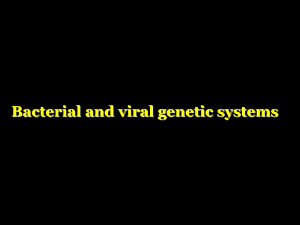
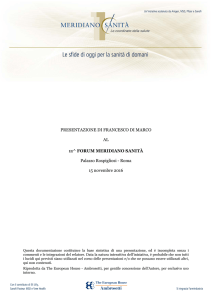
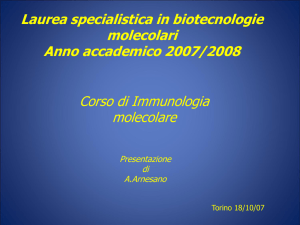
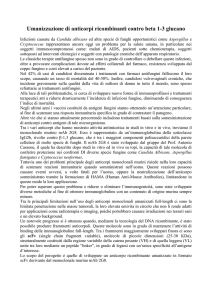
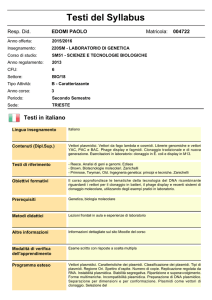
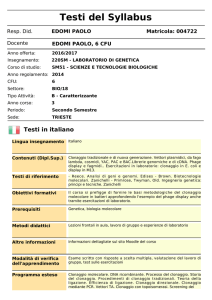
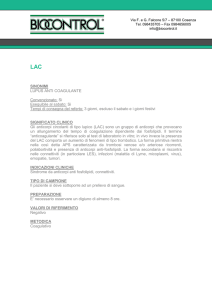
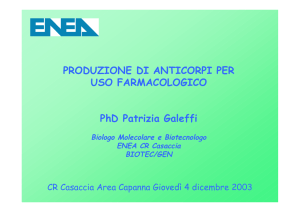
![Lezione 15 Virus [modalità compatibilità]](http://s1.studylibit.com/store/data/000771737_1-84b1cca561c5813066d1b76125338a98-300x300.png)
